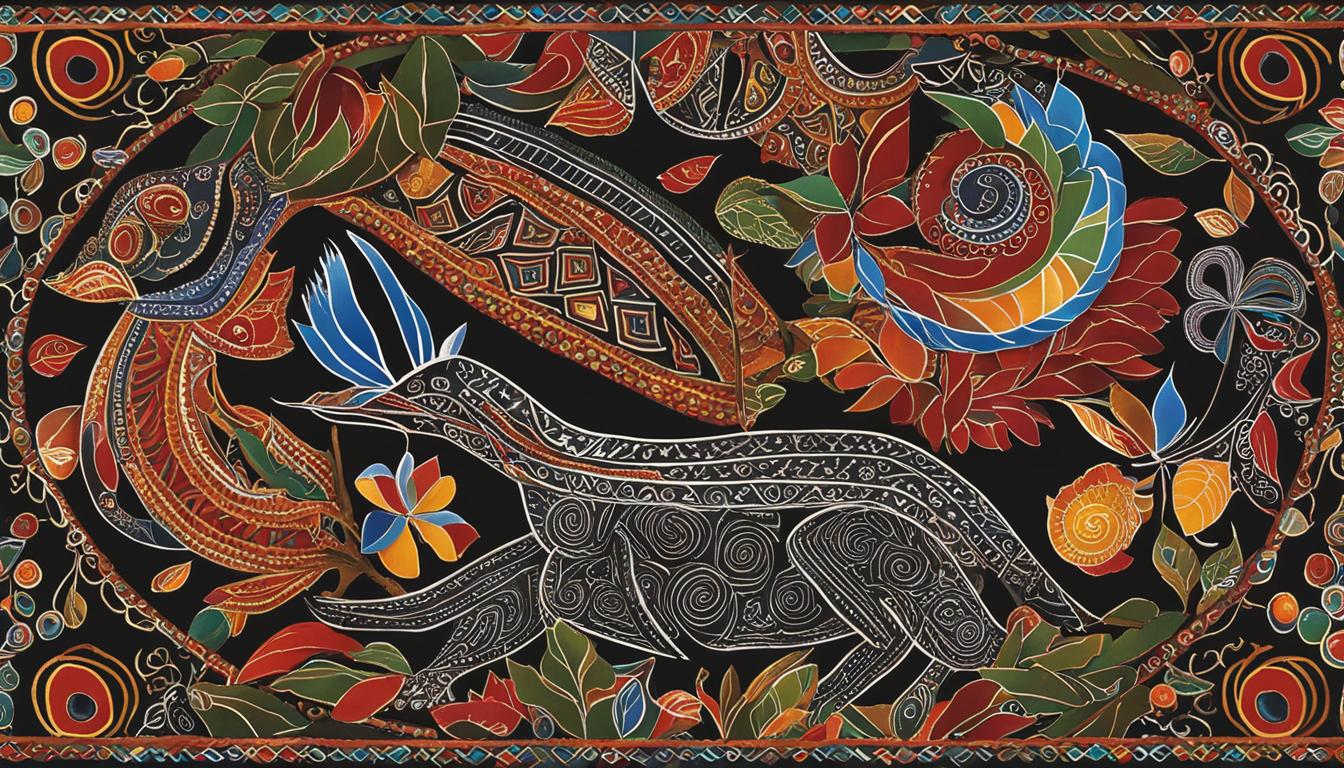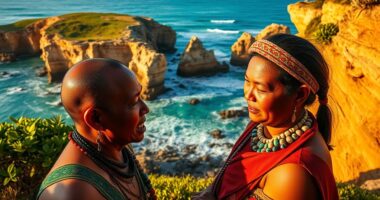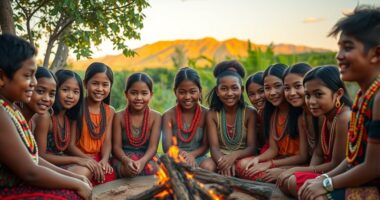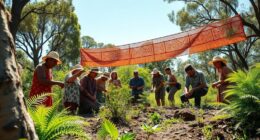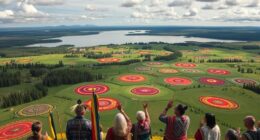Maintaining the Australian Indigenous languages is crucial in preserving and celebrating the diverse cultural heritage of the Aboriginal and Torres Strait Islander communities. These languages are not just languages; they hold valuable knowledge about law, geography, history, and spirituality. However, the risk of these languages disappearing grows as the older generations pass away, highlighting the urgent need to raise awareness and support efforts to revitalize and preserve them.
Key Takeaways:
- Australian Indigenous languages are an integral part of Aboriginal and Torres Strait Islander culture, representing a deep connection to their history, land, and spirituality.
- These languages contain extensive knowledge about various aspects of life, including law, geography, and spirituality.
- Many Indigenous languages are at risk of being lost forever as elders pass on, highlighting the urgent need to revitalize and preserve them.
- The preservation of Australian Indigenous languages plays a crucial role in honoring and celebrating the diverse linguistic tapestry of Indigenous cultures in Australia.
The Significance of Indigenous Languages
Indigenous languages hold immense cultural significance beyond their role as a means of communication. They encapsulate centuries of knowledge about law, geography, history, family, philosophy, and religion, providing a unique perspective on life. These languages are deeply intertwined with the land and carry a spiritual weight that connects Indigenous nations to their ancestors and cultural identity.
Preserving and revitalizing Indigenous languages is crucial for safeguarding the rich tapestry of Indigenous culture and heritage. It ensures the transmission of ancestral wisdom, fosters a sense of belonging among communities, and strengthens the connection between language, land, and Indigenous identity. By embracing language revitalization efforts, we contribute to the preservation and celebration of traditional languages and the vibrant cultures they represent.
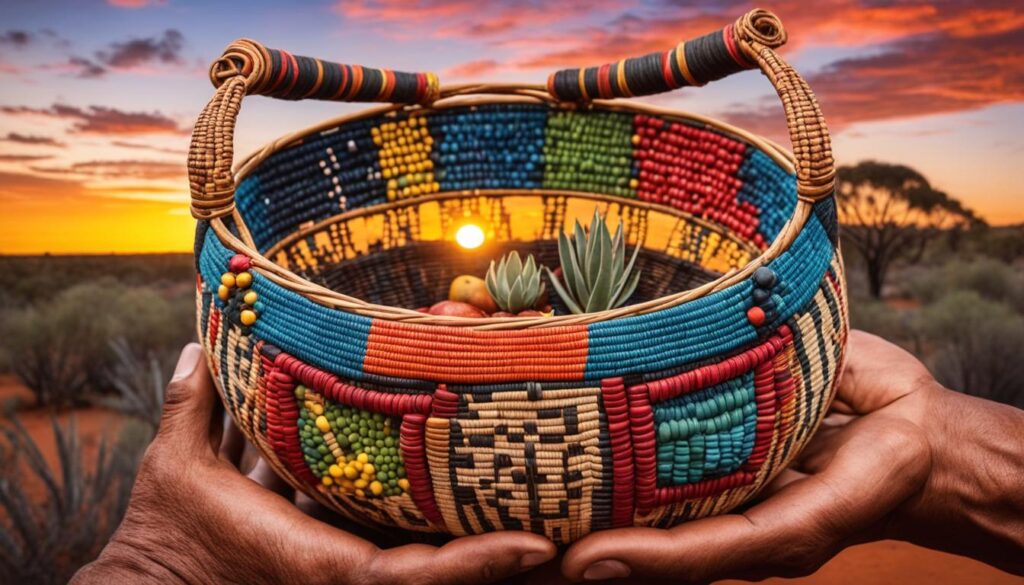
The Decline of Indigenous Languages
In the late 18th century, Australia was home to around 250 distinct Indigenous language groups, with many having several dialects. Today, only around 120 of these languages are still spoken, and many are at risk of being lost forever. The decline of Indigenous languages is attributed to historical factors such as assimilation policies and the loss of language transmission between generations. Urgent action is needed to reverse this trend and ensure the preservation of Indigenous languages for future generations.
Indigenous languages are an integral part of Australia’s cultural heritage. They are not only a means of communication but also an expression of identity, heritage, and connection to the land. Language loss not only erodes cultural diversity but also diminishes the wealth of knowledge and wisdom embedded within Indigenous languages.
The Impact of Language Loss
The loss of Indigenous languages has profound implications for Indigenous communities and cultural preservation. Language loss leads to the erosion of cultural identity, as language is closely tied to customs, traditions, and worldviews. It disconnects younger generations from their ancestral roots and hinders the transmission of unique knowledge and practices.
Language loss is like losing a piece of ourselves, our history, and our connection to the land. It is a loss that diminishes our cultural vitality and threatens the survival of our Indigenous heritage. We must act now to reverse this decline and preserve our languages for generations to come.
Moreover, language loss adversely affects social and emotional well-being. Indigenous languages are deeply embedded in the fabric of community life, playing a crucial role in strengthening social bonds, fostering intergenerational relationships, and promoting mental health and resilience. When languages are lost, communities may experience a sense of grief, disconnection, and loss of cultural autonomy.
The Importance of Language Preservation
Language preservation is key to safeguarding the rich tapestry of Indigenous cultures and promoting cultural revitalization. By preserving Indigenous languages, we honor the knowledge and wisdom accumulated over centuries. Language preservation is not solely about language revival; it is a holistic approach that encompasses cultural education, community engagement, and intergenerational knowledge transmission.
The preservation of Indigenous languages is vital for:
- Maintaining cultural diversity and uniqueness.
- Strengthening cultural identity and pride.
- Revitalizing traditional practices, ceremonies, and storytelling.
- Fostering intergenerational connections and knowledge transfer.
- Empowering Indigenous communities and promoting reconciliation.
To truly preserve Indigenous languages, it is essential to involve Indigenous communities in the process. Community-led initiatives, language revitalization programs, and partnerships between Indigenous and non-Indigenous organizations are crucial in ensuring the sustainability and success of language preservation efforts.
Challenges and Solutions
Reviving and preserving Indigenous languages presents unique challenges. Many languages have incomplete documentation, and linguistic research is often based on limited resources. There is a need for greater investment in language revitalization programs, linguistic research, and the development of culturally appropriate teaching materials.
Language revival requires more than just the restoration of words and grammar. It requires a deep understanding of cultural concepts, the revival of traditional contexts, and the creative adaptation of contemporary terms.
Despite these challenges, there are encouraging examples of successful language preservation projects and initiatives. Innovative approaches, such as the use of technology, digital archives, and community engagement, have proven effective in revitalizing Indigenous languages.
Preserving Indigenous Languages for Future Generations
We have the responsibility to partner with Indigenous communities, support language preservation efforts, and amplify the voices and stories embedded within Indigenous languages. By nurturing and celebrating Indigenous languages, we not only preserve a vital part of Australia’s cultural fabric but also contribute to the well-being and cultural strength of Indigenous communities.
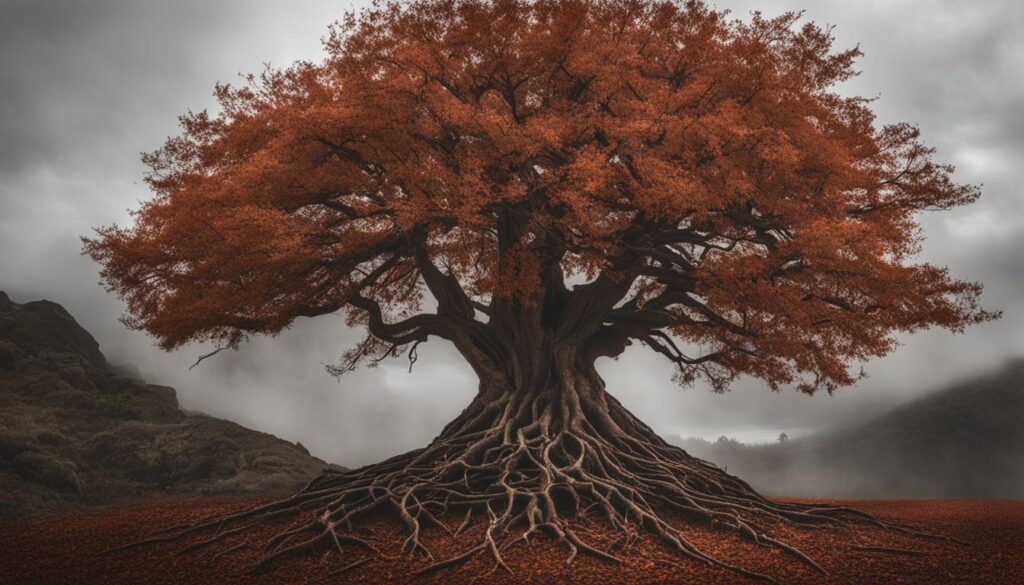
| Causes of Language Loss | Effects of Language Loss | Solutions for Language Preservation |
|---|---|---|
| Historical assimilation policies | Loss of cultural identity | Investment in language revitalization programs |
| Disruption of language transmission between generations | Social and emotional impact | Community-led language preservation initiatives |
| Lack of resources and documentation | Diminished intergenerational knowledge transfer | Partnerships between Indigenous and non-Indigenous organizations |
The Importance of Language Preservation Programs
Language preservation programs are integral to the revitalization and conservation of Indigenous languages. These programs play a vital role in raising awareness, engaging communities, and ensuring the transmission of cultural knowledge. By supporting these initiatives, we can actively contribute to the preservation of Aboriginal and Torres Strait Islander cultures and foster a deeper appreciation for the rich diversity of Indigenous languages.
Engaging Communities for Language Revitalization
Language preservation programs prioritize community engagement, recognizing the importance of involving community members in language development. By empowering Indigenous communities to take ownership of language revitalization efforts, these programs create sustainable initiatives that reflect the unique cultural context and needs of each community.
Community engagement often encompasses various activities, such as:
- Language classes and workshops
- Community events and gatherings
- Storytelling sessions
- Collaborative language documentation projects
These programs provide opportunities for community members of all ages to participate in the revitalization process. By actively engaging with the language and culture, individuals can develop a sense of pride and identity, strengthening their connections to their heritage.
Preserving Cultural Knowledge Through Language Revitalization
“Language is a doorway to cultural preservation, allowing us to pass on our traditions, histories, and values from one generation to another.” – Elder Jane Smith
Language preservation programs not only aim to revitalize Indigenous languages but also serve as a means of preserving cultural knowledge and traditions. Indigenous languages encompass invaluable knowledge about law, history, spirituality, and various aspects of daily life. Reviving these languages ensures the transmission of cultural practices, stories, and traditions, fostering a strong cultural identity within Indigenous communities.
The Benefits of Language Preservation Programs
The impact of language preservation programs goes beyond the realm of linguistics and cultural preservation. These initiatives bring about a host of benefits for individuals and communities, including:
- Preserving cultural autonomy and Indigenous identity
- Strengthening community connections
- Promoting mental health and well-being
- Fostering intergenerational communication and understanding
Additionally, Indigenous languages are closely connected to land, providing a deeper connection to the environment and enhancing cultural practices related to land management and conservation.
Supporting Language Preservation Programs
To ensure the continued success of language preservation programs, it is crucial for individuals, organizations, and governments to provide support and resources. This support can manifest in various forms, such as:
- Funding for language classes and workshops
- Collaboration with Indigenous communities
- Integration of Indigenous languages in educational curricula
- Partnerships with universities and research institutions
By actively supporting these programs, we play a significant role in nurturing the revitalization and preservation of Indigenous languages, contributing to the cultural diversity and richness of Australia.
| Benefits of Language Preservation Programs | Supporting Actions |
|---|---|
| Preserving cultural autonomy and Indigenous identity | – Collaboration with Indigenous communities – Integration of Indigenous languages in educational curricula |
| Strengthening community connections | – Funding for language classes and workshops – Partnerships with universities and research institutions |
| Promoting mental health and well-being | – Integration of Indigenous languages in healthcare services – Awareness campaigns on the benefits of language preservation |
| Fostering intergenerational communication and understanding | – Language revitalization initiatives for youth and elders – Community events that promote language use and storytelling |

Through language preservation programs, we can actively contribute to the revitalization and conservation of Indigenous languages. By supporting community engagement, cultural preservation, and promoting the use of Indigenous languages, we honor and celebrate the rich linguistic heritage of Aboriginal and Torres Strait Islander cultures.
University Initiatives in Language Preservation
Universities have an important role to play in the preservation and revitalization of Indigenous languages. At La Trobe University, we are committed to incorporating Aboriginal and Torres Strait Islander philosophies, values, and knowledge into the fabric of our institution.
As part of our Indigenous Education Strategy, we actively weave Indigenous culture into our campuses. Each campus at La Trobe has its own name derived from the local Indigenous language, symbolizing our dedication to honoring and preserving these languages. Indigenous languages are also integrated into ceremonies, teachings, and various aspects of university life. By incorporating Indigenous languages and culture into education, we contribute to their preservation and revival.
La Trobe University’s initiatives in language preservation align with our commitment to cultural integrity and Indigenous knowledge. Through collaboration with Indigenous communities, linguists, and experts, we aim to ensure that Indigenous languages are given the attention and respect they deserve. By investing in language revival programs, research, and community engagement, we strive to empower Indigenous communities and strengthen cultural identity.
“At La Trobe University, we believe that language preservation is not just an academic pursuit but a moral responsibility. By incorporating Indigenous languages into our institution, we show our commitment to preserving and celebrating the rich linguistic heritage of Aboriginal and Torres Strait Islander peoples.”
La Trobe University’s Language Revival Initiatives:
| Initiative | Description |
|---|---|
| Language-inclusive ceremonies | Incorporating Indigenous languages into university ceremonies to honor and recognize their significance in cultural traditions. |
| Indigenous language courses | Offering academic programs that provide opportunities for students to learn, engage, and contribute to Indigenous language revitalization efforts. |
| Collaborative research | Working with Indigenous communities and linguists to document, preserve, and revitalize Indigenous languages through rigorous research and community engagement. |
| Community partnerships | Collaborating with local Indigenous communities to co-develop language preservation initiatives and support community-led efforts. |
La Trobe University’s commitment to Indigenous language preservation extends beyond the confines of academic programs and initiatives. It is a dedication to preserving cultural heritage, fostering linguistic diversity, and ensuring the continued vibrancy of Indigenous languages for generations to come.
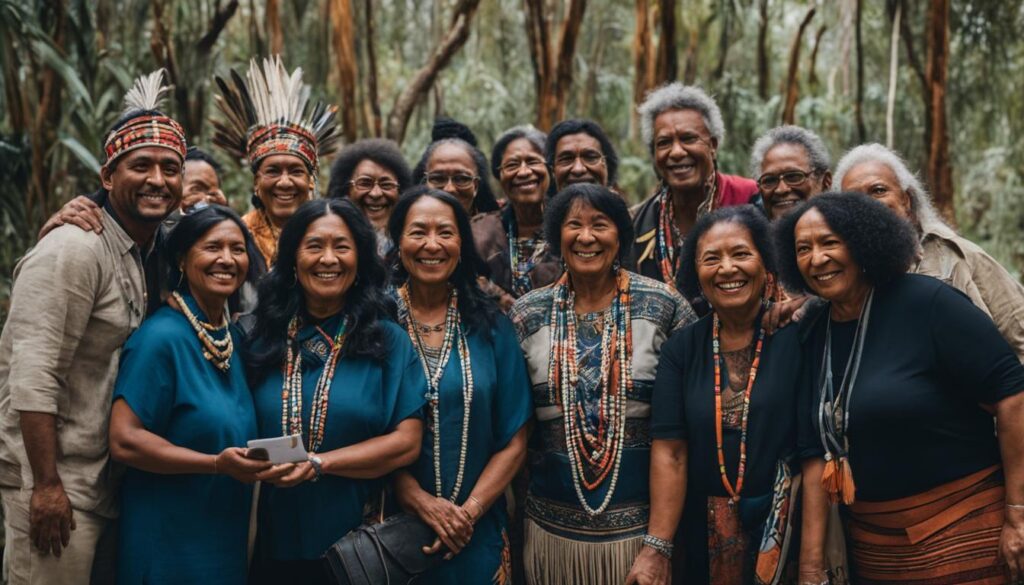
Funding Aboriginal and Torres Strait Islander Language Dictionaries
At the forefront of language preservation efforts, the AIATSIS Dictionaries Program plays a vital role in supporting the publication of Aboriginal and Torres Strait Islander language dictionaries. The program aims to advance language preservation, while also strengthening the cultural heritage and identities of Indigenous communities. By providing funding for dictionaries ready for publication within six months, the program ensures that these valuable resources are made available to future generations.
Supported by the relevant Indigenous language communities, the dictionaries funded by the program undergo rigorous assessment in terms of their significance and quality. This commitment to excellence ensures that the published dictionaries accurately capture the essence of Aboriginal languages and Torres Strait Islander languages, serving as important resources for language learners, researchers, and communities alike.
Sample Funding Criteria for Aboriginal and Torres Strait Islander Language Dictionaries
| Criteria | Description |
|---|---|
| Relevance | Dictionaries focused on Aboriginal languages or Torres Strait Islander languages are eligible for funding. |
| Community Support | Applicants must demonstrate strong support from the relevant Indigenous language communities. |
| Publication Readiness | Dictionaries that are ready for publication within six months are prioritized for funding. |
| Significance | The dictionaries must hold significant value in terms of cultural preservation and language revitalization. |
| Quality | The dictionaries should meet a high standard in terms of linguistic accuracy, usability, and cultural representation. |
The publication of Aboriginal and Torres Strait Islander language dictionaries is essential in preserving and promoting the unique languages of these Indigenous cultures. These dictionaries serve as invaluable resources that contribute to the revitalization and perpetuation of Aboriginal languages and Torres Strait Islander languages, ensuring their endurance for generations to come.
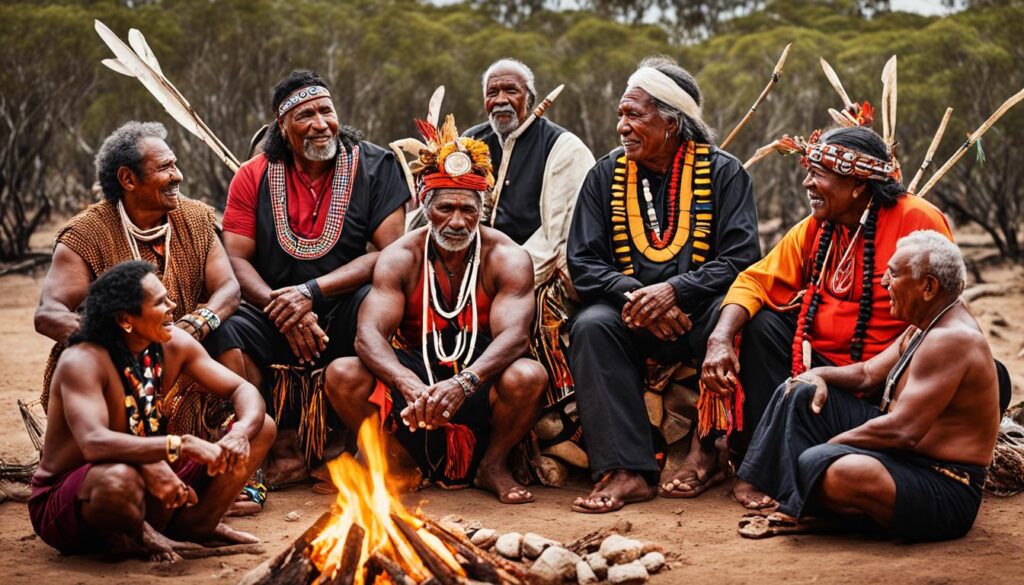
The Challenges of Language Revival
Reviving Aboriginal languages poses various challenges. As experts in the field, we understand the complexities involved in preserving and revitalizing these rich linguistic traditions. Language revival efforts rely on the expertise of passionate linguists and cultural preservationists who work tirelessly to ensure the survival of Aboriginal languages.
One of the major challenges faced by language revival experts is the limited resources available for their work. These experts often have to rely on historical translations and outdated missionary dictionaries, which may not accurately represent the nuances and intricacies of the original languages.
In addition to spelling and grammar, translating the meaning of words back into the language poses another challenge. Aboriginal languages are deeply rooted in cultural concepts and Indigenous knowledge systems, making it essential to capture the true essence of these words during the revival process.
Contemporary words and concepts, especially those related to technology, can be particularly challenging to translate into Aboriginal languages. These concepts may not have existed at the time when the languages were last spoken fluently, requiring creative translations to bridge the gap between ancient languages and modern-day contexts.
Despite these challenges, dedicated efforts are being made to revive and restore Aboriginal languages. Linguistic experts and cultural preservationists work diligently to recover as many words and linguistic concepts as possible, drawing on historical records, oral traditions, and the knowledge of elders.
“Preserving and revitalizing Aboriginal languages is crucial in maintaining the cultural integrity of Indigenous communities and fostering a deep sense of cultural identity.”
The Benefits of Language Preservation
The preservation and revival of Indigenous languages offer numerous benefits that go beyond mere communication. These efforts play a crucial role in strengthening cultural connections, fostering a sense of pride and identity, and revitalizing traditional cultural activities. By learning and speaking an Indigenous language, individuals become active participants in their cultural heritage, contributing to the preservation of cultural autonomy and the overall well-being of Aboriginal and Torres Strait Islander communities.
When we revive and preserve Aboriginal languages, we forge a stronger connection with our rich cultural heritage. Language is the key to unlocking the wisdom and knowledge passed down from our ancestors, providing us with a greater understanding and appreciation of our Indigenous culture. It allows us to engage in our traditional practices, ceremonies, storytelling, and rituals, restoring a sense of pride in our unique identity.
Moreover, language revival has been linked to improved mental health outcomes and lower rates of suicide within Indigenous communities. Learning and participating in our native languages offer a sense of belonging and purpose, generating a positive impact on our overall well-being. By reconnecting with our language, we promote cultural healing, resilience, and stronger community ties.
“Language and culture evolve hand in hand. By preserving and revitalizing our Indigenous languages, we embrace a holistic approach to health and well-being. We must value our languages as the vital thread that keeps our cultural fabric intact.” – Elder Margaret Jackson
Preserving Indigenous languages also helps us to revive and celebrate traditional cultural activities. Our languages are deeply intertwined with our cultural practices, including traditional dance, song, art, and connection to land. By revitalizing our languages, we reignite these cultural activities, creating opportunities for intergenerational learning, and ensuring the preservation of our ancestral knowledge for future generations.
In summary, language preservation is essential for strengthening cultural connections, promoting mental well-being, and reviving traditional cultural activities within Aboriginal and Torres Strait Islander communities. By embracing the revival and preservation of Indigenous languages, we honor and celebrate our cultural heritage, ensuring that our unique identity as First Nations peoples continues to thrive for generations to come.
Language Preservation Projects: Talking Books
Talking books, utilizing sound printing technology, have emerged as a valuable method to preserve Indigenous languages and improve literacy levels within Aboriginal communities. This innovative approach combines the traditional medium of books with audio recordings, creating a dynamic learning experience that fosters language preservation and promotes literacy.
“Talking books are a powerful tool in our efforts to preserve our Indigenous languages and pass them on to future generations.” – Indigenous Language Advocate
Sound-printed books are produced primarily by Aboriginal organizations that work closely with Indigenous communities to ensure cultural accuracy and relevance. These books feature embedded codes on each page that readers can scan using a smartphone or a specialized device. By scanning the code, the corresponding audio file is played, enabling readers to hear the pronunciation and intonation of the words and phrases.
This interactive experience not only aids language learners in understanding the correct pronunciation but also fosters a deeper connection to the cultural context in which the language is spoken.
The benefits of talking books extend beyond language preservation. They also contribute significantly to literacy improvement within Aboriginal communities. By integrating oral storytelling and written text, these books enhance reading skills and promote a love for literature.
The success of sound-printed books in maintaining Indigenous languages and promoting literacy highlights the importance of cultural preservation through innovative approaches. Through the continued support and expansion of language preservation projects like talking books, we can contribute to the revitalization of Indigenous languages and the empowerment of Aboriginal communities.
Language Preservation Projects: Dictionaries
Language dictionaries play a crucial role in preserving and documenting Indigenous languages, contributing to cultural preservation and providing valuable educational resources. Many dictionaries are developed in collaboration with Indigenous communities, ensuring culturally appropriate translations, illustrations, and pronunciation guides. These dictionaries serve as essential tools for language learners, promoting the use and understanding of Indigenous languages within communities.
“Dictionaries are like roadmaps, guiding us through the complex and beautiful landscape of Indigenous languages. They provide us with the knowledge and tools we need to navigate, learn, and appreciate the intricacies of these languages.”
Collaborating with Indigenous communities ensures that these dictionaries accurately reflect the language, culture, and unique expressions used by the community. The inclusion of illustrations enhances the learning experience, providing visual representations of cultural contexts and deepening understanding.
Let’s take a look at an example of an Indigenous language dictionary:
| Dictionary Title | Language | Features |
|---|---|---|
| Milba Yalma: Kamilaroi Dictionary | Kamilaroi |
|
Table: Example of an Indigenous language dictionary
The Kamilaroi dictionary, “Milba Yalma,” provides a comprehensive resource for learners of the Kamilaroi language. It offers culturally sensitive translations, a phonetic pronunciation guide, and detailed definitions. Moreover, it includes insights into Indigenous cultural practices, traditional stories, and proverbs, enriching the learning experience and promoting a deeper understanding of the Kamilaroi culture.
Language dictionaries significantly contribute to language preservation projects, fostering the revitalization and continued use of Indigenous languages for generations to come.
Language Preservation Projects: Apps
Language learning apps have revolutionized the way we approach language preservation. In our digital age, these apps have become essential tools in revitalizing Indigenous languages and making language learning accessible to a wider audience.
These language learning apps provide a gateway to the rich resources and dictionaries of Indigenous languages, enabling learners to immerse themselves in the beauty and intricacies of the language. By embracing digital tools, we can ensure that the preservation and learning of Indigenous languages are brought into the modern era.
Two notable language learning apps that have made significant contributions to language preservation efforts are Ma Gamilaraay and Ma! Iwaidja. These apps serve as platforms for language learners to explore, practice, and revitalize Aboriginal languages in an engaging and interactive manner.
| Language Preservation App | Features | Availability |
|---|---|---|
| Ma Gamilaraay | – Pronunciation guide – Vocabulary exercises – Audio recordings |
Available on iOS and Android |
| Ma! Iwaidja | – Interactive lessons – Storytelling activities – Cultural immersion |
Available on iOS and Android |
These apps serve as powerful tools for language learners, allowing them to learn at their own pace and engage with Indigenous languages anytime, anywhere. Through the use of digital tools, we can bridge the gap between generations and ensure that the beauty and cultural significance of Indigenous languages are preserved for future generations.
Language Preservation Projects: Wunungu Awara
At the forefront of language preservation projects is Wunungu Awara, a groundbreaking initiative that utilizes 3D animation to engage younger generations and revitalize interest in Indigenous languages. The name itself, “Wunungu Awara,” means “a strong and healthy, vital place,” reflecting the project’s commitment to rejuvenating cultural heritage.
Wunungu Awara combines the power of storytelling and songs to convey cultural knowledge and foster language learning. Through visually captivating 3D animations, this project brings Indigenous languages to life, making them more accessible and engaging for learners of all ages.
Using modern technologies and creative approaches, Wunungu Awara ensures the survival and vitality of Indigenous languages. By embracing 3D animation as a storytelling tool, the project sparks interest in language preservation and cultural revitalization among the younger generation.
With Wunungu Awara, language preservation transcends traditional methods and enters the digital realm, capturing the attention and imagination of today’s tech-savvy individuals. This innovative approach not only helps Indigenous communities preserve their languages but also opens doors for cross-cultural exchanges and a deeper understanding of Australia’s rich linguistic diversity.
Through the combination of traditional knowledge and modern technologies, Wunungu Awara paves the way for a bright future where Indigenous languages thrive and continue to be a vibrant part of Australian cultural heritage.
With the help of 3D animation, Wunungu Awara breathes new life into Indigenous languages and ensures their cultural revitalization.
Language Preservation Projects: Living Archive of Aboriginal Languages
The Living Archive of Aboriginal Languages is a digital archive dedicated to preserving endangered literature in Australian Aboriginal languages. Our project is committed to collecting and safeguarding books and materials in various languages, ensuring that the vibrant voices and cultural expressions of Aboriginal communities are preserved for future generations.
Through collaboration with Aboriginal authorities and communities, we work to maintain strong connections and enable the accessibility of the collected works. Our goal is to facilitate collaborative research and language preservation efforts, promoting community collaboration in preserving and revitalizing endangered literature and languages.
By embracing the power of digital archives, we ensure that these invaluable resources can be accessed and utilized by linguists, researchers, and community members alike. The Living Archive of Aboriginal Languages is a testament to the strength of community collaboration and the collective efforts in preserving the world’s linguistic diversity.
Conclusion
The preservation of Australian Indigenous languages is crucial for safeguarding our cultural heritage and upholding our Indigenous identity. Through language preservation programs, community initiatives, and the utilization of modern technology, we are actively working towards revitalizing and ensuring the survival of Aboriginal languages and Torres Strait Islander languages.
By recognizing the significance of language preservation, we actively contribute to the honor and celebration of the diverse linguistic tapestry found within Australia’s Indigenous cultures. Aboriginal languages and Torres Strait Islander languages are not just means of communication; they hold within them essential knowledge about various aspects of life, including law, geography, history, and spirituality.
Language preservation programs play a vital role in engaging communities, promoting the use of Indigenous languages, and involving community members in language development. By supporting these initiatives, we can ensure the transmission of cultural knowledge, strengthen community connections, and foster a deep appreciation for Aboriginal and Torres Strait Islander cultures.
As we work together to preserve and revitalize Aboriginal languages and Torres Strait Islander languages, we actively contribute to the preservation of our cultural heritage, the maintenance of our Indigenous identity, and the rich tapestry of languages that define Australia’s First Nations peoples.
FAQ
Why is the preservation of Australian Indigenous languages important?
The preservation of Australian Indigenous languages is vital in celebrating and preserving the rich cultural heritage of Aboriginal and Torres Strait Islander peoples. These languages hold immense knowledge about various aspects of life and are deeply connected to the land and spirituality.
How many Indigenous languages are still spoken today?
Today, only around 120 of the approximately 250 distinct Indigenous languages that once existed in Australia are still spoken.
Why are Indigenous languages at risk of being lost?
The decline of Indigenous languages is attributed to historical factors such as assimilation policies and the loss of language transmission between generations.
What role do language preservation programs play?
Language preservation programs raise awareness, revitalize, and preserve Indigenous languages by engaging communities, involving community members, and promoting the use of Indigenous languages.
How are universities involved in preserving Indigenous languages?
Universities like La Trobe University incorporate Aboriginal and Torres Strait Islander philosophies and values into their education strategies, incorporate Indigenous languages into ceremonies and teachings, and use Indigenous language names for their campuses to contribute to the preservation and revival of these languages.
How does the AIATSIS Dictionaries Program support language preservation?
The AIATSIS Dictionaries Program provides funding for the publication of Aboriginal and Torres Strait Islander language dictionaries, supporting the advancement of languages and strengthening the cultures and identities of Indigenous peoples.
What are the challenges of reviving Aboriginal languages?
Reviving Aboriginal languages poses challenges such as limited resources, reliance on historical translations, translating contemporary words and concepts, and recovering as many words and linguistic concepts as possible.
What are the benefits of language preservation?
Language preservation strengthens cultural connections, fosters a sense of pride and identity, revitalizes traditional cultural activities, promotes mental health, lowers suicide rates, and preserves cultural autonomy.
How do talking books contribute to language preservation?
Talking books, utilizing sound printing technology, help preserve Indigenous languages and improve literacy levels within Aboriginal communities by providing audio playback of the corresponding text.
How do language dictionaries contribute to language preservation?
Language dictionaries provide culturally appropriate translations, illustrations, and pronunciation guides, serving as valuable resources for language learners and promoting the use and understanding of Indigenous languages within communities.
How do language learning apps contribute to language preservation?
Language learning apps provide access to Indigenous language resources and dictionaries, making language learning more accessible and engaging, thus contributing to language revitalization and preservation efforts.
What is the Wunungu Awara project?
The Wunungu Awara project uses 3D animation, storytelling, and songs to engage younger generations and revitalize interest in Indigenous languages, ensuring their survival and vitality.
What is the Living Archive of Aboriginal Languages?
The Living Archive of Aboriginal Languages is a digital archive dedicated to preserving endangered literature in Australian Aboriginal languages, collaborating with Aboriginal authorities and communities to ensure accessibility for research and language preservation efforts.
Why is the preservation of Australian Indigenous languages important?
The preservation of Australian Indigenous languages is vital for preserving cultural heritage and maintaining Indigenous identity, honoring and celebrating the diverse linguistic tapestry of Australia’s Indigenous cultures.
